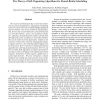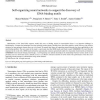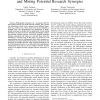252 search results - page 44 / 51 » Using OWL to model biological knowledge |
SASO
2007
IEEE
14 years 1 months ago
2007
IEEE
The study of synchronization has received much attention in a variety of applications, ranging from coordinating sensors in wireless networks to models of fireflies flashing in...
NN
2006
Springer
13 years 7 months ago
2006
Springer
Identification of the short DNA sequence motifs that serve as binding targets for transcription factors is an important challenge in bioinformatics. Unsupervised techniques from t...
ASUNAM
2011
IEEE
12 years 7 months ago
2011
IEEE
—Bibliographic databases are a prosperous field for data mining research and social network analysis. They contain rich information, which can be analyzed across different dimen...
BMCBI
2007
13 years 7 months ago
2007
Background: Metalloproteins are proteins capable of binding one or more metal ions, which may be required for their biological function, for regulation of their activities or for ...
EDBT
2009
ACM
14 years 2 months ago
2009
ACM
There has been an explosion of hyperlinked data in many domains, e.g., the biological Web. Expressive query languages and effective ranking techniques are required to convert this...



